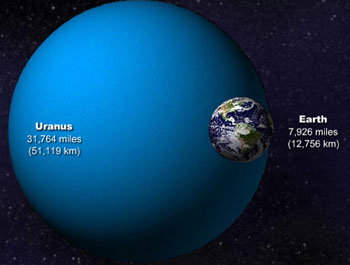Uranus does not have a liquid metallic core like the other gas giants.
The average temperature on Uranus is around minus 360 degrees Fahrenheit.
Mean distance from Sun is (2.871 billion km/1.784 billion mi).
Uranus has a massive axis tilt of roughly 90 degrees. This means the north and south poles are often located where the equator is on the Earth. Because of the planet's unusual orientation, Uranus's rings are perpendicular to its orbital path about the sun.
The reason for the massive tilt of Uranus is unknown. According to the scientists, a collision with a space object may have changed the slope of its axis.
Uranus has 13 rings with 2 being very far from the planet. It is thought that the rings were probably formed by a shattered moon. They are named using Greek symbols and other numerical values: 1986U2R/ζ, 6, 5, 4, α, β, η, γ, δ, λ, ε, ν, μ
The rings are extremely difficult to see from Earth, but were photographed by the Voyager probe as it passed the planet.
Nasa’s Voyager 2 is the only probe to visit Uranus. Voyager 2 was launched in 1977 and it finally made it to Uranus on January 24, 1986 (it’s closest approach).
It takes Uranus 84 Earth years to make one rotation around the Sun. Since Uranus takes 84 years to go around the sun, this means that each of its poles is in daylight for 42 years and in darkness for the next 42.
Uranus is about four times as large as the Earth and 15 times as heavy.
Uranus is now known to have 27 moons. But these are tiny, and even if we add their total weight it is less than half of the total weight of Triton - Neptune's largest moon.
The moons are named after characters in the works of Shakespeare and Alexander Pope.
Oddly, a number of the moons rotate the opposite direction of Uranus.
Titania is the largest known moon of Uranus.
The radioactive element Uranium was named after Uranus in 1789! The German chemist Martin Heinrich Klaproth discovered Uranium.
 Sources:
Sources:
http://en.wikipedia.org/wiki/Uranus
http://science.nationalgeographic.com/science/space/solar-system/uranus-article/
http://solarsystem.nasa.gov/planets/profile.cfm?Object=Uranus&Display=Facts
http://planetfacts.org/planet-uranus-facts/
http://voyager.jpl.nasa.gov/science/uranus_moons.html